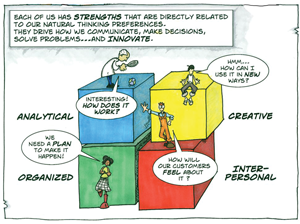
Can innovation be taught?
 bh IN BRIEF
Rick is the co-founder of Floworks Training, as well as a Designer and Innovation Practice Leader at Juice Inc., based in Guelph, Ontario. Rick has been an educator and trainer since 1985, working with Fortune 500 corporations
and hundreds of smaller companies, designing and facilitating experiential training programs. Rick has developed the Innovation in a Box™ training program and is writing and illustrating a Graphic Innovation Guide.
For more information: www.juiceinc.com
|
I recently had this conversation with a client who believed people were either creative, or they weren’t. He thought innovation was innate and not at all teachable. I told him creativity tests measure the number, range and originality of ideas a person generates. And so I reframed the question: “Do you think an individual or team can generate a wider range of diverse ideas?” He thought then said he still wasn’t sure.
nnovation is crucial to the success of every organization – regardless of its business. People in organizations say, “We need to be more innovative,” but at the grassroots, individuals and teams often don’t know how to translate that need into action. Like my client, many believe innovation should be reserved for the “creatives,” the lucky few who naturally generate ideas. Although it can be elusive, innovation is essential for achieving real improvements in products, services and processes. Research shows that for an average group, a structured approach to innovation versus a conventional brainstorming session with the “creatives” can lead to a 500 per cent increase in useful ideas. You may not be able to change someone’s hard-wiring, but you can absolutely increase the creative output of teams and individuals by engaging them, increasing their openness, and fostering conditions that expand the range and originality of their ideas. Before we get into how we do this, let’s review a pervasive innovation cliché that is familiar to many of us –“Just think outside the box.” What does such advice really mean? It is merely a nebulous platitude that leaves people without a clear goal or direction.Is this is why innovation continues to mystify? Boxes – or mental frameworks – are essential for managing business processes. In the case of innovation, a box provides the structure and clarity teams need to increase their output and produce useful ideas. When you tell people to “think outside the box” you are asking them to come up with great ideas without giving them the structure and clarity they need to be successful. To innovate effectively, people need methods and tools to help them build on their strengths and increase the number, range and originality of their ideas. To provide clear direction and eliminate guesswork, we have developed the i5, a fi ve-stage innovation process that includes Innovation, Investigation, Ideation, Impact and Implementation. Identification: Identify problems, needs and possibilities. Innovation efforts are often random and reactive. The first step is to proactively identify the problem as an opportunity to achieve the greatest possible potential. A well-crafted opportunity statement agreed-upon by the team is critical. Investigation: Seek understanding of both the big picture and root causes. Looking at the opportunity statement from a strategic perspective allows us to innovate from a foundation of knowledge. Ideation: Generate, strengthen and elaborate on breakthrough solutions. This is the traditionally “mystical” phase of innovation where some people are able to just “come up with ideas” more easily than others. However, this stage of innovation can be as structured and process-oriented as any other discipline and there are countless other tools to help so-called “non-creatives” out-perform the norm. Impact: Choose the right solution. Groups are often bogged down by decision-making. Provide them with tools to help them evaluate and prioritize ideas quickly and objectively, so they know what nextsteps to consider. Implementation: Map an implementation strategy. |

Strength In Numbers
We all bring different styles, beliefs, values and perspectives to the innovation process. This variety benefi ts the process because it helps to increase the number, range and originality of ideas, based on the different experiences each individual brings to the group.
